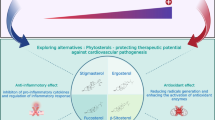Abstract
Objective
Placental lipid peroxides and thromboxane are abnormally increased in preeclampsia. Peroxides stimulate thromboxane to increase placental vasoconstriction. Antioxidants, such as β-carotene, control lipid peroxidation. Reduced levels of β-carotene (0.25 μmol/L) have been found in preeclamptic women. We hypothesized that normal (0.5 μmol/L) or elevated (1.0 μmol/L) levels of β-carotene would attenuate peroxide-induced vasoconstriction in the human placenta, whereas low levels would not.
Methods
Isolated human placental cotyledons (n = 8) were sequentially perfused with control Krebs-Ringer-bicarbonate buffer, 200 μmol/L t-butyl hydroperoxide, and then with progressively increasing concentrations of β-carotene (0.25, 0.5, and 1 μmol/L) plus t-butyl hydroperoxide. Fetal perfusion pressure was monitored continuously, and maternal and fetal effluent samples were collected for each treatment. Samples were analyzed for lipid peroxides and for thromboxane and prostacyclin by their stable metabolites thromboxane B2 (TXB2) and 6-keto-prostaglandin (PG)F1α.
Results
Compared with control, t-butyl hydroperoxide significantly increased perfusion pressure, vascular resistance, and the secretion rates of lipid peroxides, TXB2 and 6-keto-PGF1α. Perfusion with normal (0.5 μmol/L) or increased (1 μmol/L) levels of β-carotene significantly or completely inhibited t-butyl hydroperoxide-induced vasoconstriction and the increases in lipid peroxide and TXB2 secretion, but did not inhibit peroxide-induced increases in 6-keto-PGF1α secretion. Reduced levels of β-carotene (0.25 μmol/L) did not inhibit t-butyl hydroperoxide-induced vasoconstriction or the increases in lipid peroxide secretion.
Conclusions
β-carotene at levels found in normal pregnant women (0.5 μmol/L) or at levels achieved with β-carotene supplementation (1 μmol/L) inhibited peroxide-induced vasoconstriction and lipid peroxide and thromboxane secretion. Levels of β-carotene found in preeclamptic women (0.25 μmol/L) did not inhibit peroxide-induced vasoconstriction or lipid peroxide secretion.
Similar content being viewed by others
References
Sibai BM, Anderson GD. Hypertension. In: Gabbe SG, Niebyl JR, Simpson JL, eds. Obstetrics. Normal and problem pregnancies. New York: Churchill Livingstone, 1991:993–1055.
Ishihara M. Studies on lipoperoxide of normal pregnant women and of patients with toxemia of pregnancy. Clin Chim Acta 1978;84:1–9.
Wickens D, Wilkins MH, Lunec J, Ball G, Dormandy TL. Free-radical oxidation (peroxidation) products in plasma in normal and abnormal pregnancy. Ann Clin Biochem 1981;18:158–62.
Wang Y, Walsh SW, Guo J, Zhang J. The imbalance between thromboxane and prostacyclin in preeclampsia is associated with an imbalance between lipid peroxides and vitamin E in maternal blood. Am J Obstet Gynecol 1991;165:1695–700.
Wang Y, Walsh SW, Kay HH. Placental lipid peroxides and thromboxane are increased and prostacyclin is decreased in women with preeclampsia. Am J Obstet Gvnecol 1992;167: 946–9.
Walsh SW, Wang Y. Trophoblast and placental villous core production of lipid peroxides, thromboxane, and prostacyclin in preeclampsia. J Clin Endocrinol Metab 1995;80:1888–93.
Walsh SW, Wang Y, Jesse R. Placental production of lipid peroxides, thromboxane, and prostacyclin in preeclampsia. Hyper-tens Pregn 1996;15:101–11.
Walsh SW. Lipid peroxidation in pregnancy. Hypertens Pregn 1994;13:1–32.
Walsh SW. Preeclampsia: An imbalance in placental prostacyclin and thromboxane production. Am J Obstet Gvnecol 1985;152: 335–40.
Halliwell B, Gutteridge JMC. The antioxidants of human extracellular fluids. Arch Biochem Biophys 1990;280:1–8.
Krinsky NI. Mechanism of action of biological antioxidants. Proc Soc Exp Biol Med 1992;200:248–54.
Machlin LJ, Bendich A. Free radical tissue damage: Protective role of antioxidant nutrients. FASEB J 1987;1:441–5.
Barber DA, Hams SR. Oxygen free radicals and antioxidants: A review. Am Pharm 1994;NS34:26–35.
Jendryczko A, Drozdz M. Plasma retinol, p-carotene and vitamin E levels in relation to the future risk of preeclampsia. Zentralbl Gynakol 1989;111:1121–3.
Mikhail MS, Anyaegbunam A, Garfinkel D, Palan PR, Basu J, Romney SL. Preeclampsia and antioxidant nutrients: Decreased plasma levels of reduced ascorbic acid, a-tocopherol, and beta-carotene in women with preeclampsia. Am J Obstet Gynecol 1994;171:150–7.
Walsh SW, Wang Y. Deficient glutathione peroxidase activity in preeclampsia is associated with increased placental production of thromboxane and lipid peroxides. Am J Obstet Gynecol 1993;169:1456–61.
Wang Y, Walsh SW. Antioxidant activities and mRNA expression of superoxide dismutase, catalase, and glutathione peroxidase in normal and preeclamptic placentas. J Soc Gynecol Invest 1996;3:179–84.
Bendich A. Biological functions of dietary carotenoids. Ann NY AcadSci 1993;691:61–7.
Carughi A, Hooper F. Plasma carotenoid levels before and after supplementation with a carotenoid complex. Ann NY Acad Sci 1993;691:244–5.
Walsh SW, Wang Y, Jesse R. Peroxide induces vasoconstriction in the human placenta by stimulating thromboxane. Am J Obstet Gynecol 1993;169:1007–12.
Frew JE, Jones P, Scholes G. Spectrophotometric determination of hydrogen peroxide and organic hydroperoxides at low concentrations in aqueous solution. Anal Chim Acta 1983;155:139–50.
Walsh SW, Wang Y. Secretion of lipid peroxides by the human placenta. Am J Obstet Gynecol 1993;169:1462–6.
Holies SM, Wang Y, Romney A, Walsh SW. Vitamin E attenuates peroxide induced vasoconstriction in the human placenta. Hypertens Pregn (in press).
Hemler ME, Cook HW, Lands WEM. Prostaglandin biosynthesis can be triggered by lipid peroxides. Arch Biochem Biophvs 1979;193:340–5.
Kulmacz RJ, Lands WEM. Requirements for hydroperoxide by the cyclooxygenase and peroxidase activities of prostaglandin H synthase. Prostaglandins 1983;25:531–40.
Hubel CA, Davidge ST, McLaughlin MK. Lipid hydroperoxides potentiate mesenteric artery vasoconstrictor responses. Free Radic Biol Med 1993;14:397–407.
Halliwell B, Gutteridge JMC. Free radicals in biology and medicine. Oxford: Oxford University Press, 1989, pp. 225, 261.
Nelson DM, Walsh SW. Thromboxane and prostacyclin production by different compartments of the placental villus. J Clin Endocrinol Metab 1989;68:676–83.
Thorp JA, Walsh SW, Brath PC. Low-dose aspirin inhibits thromboxane, but not prostacyclin, production by human placental arteries. Am J Obstet Gynecol 1988;159:1381–4.
Kennedy TA, Liebler DC. Peroxyl radical scavenging by 3-caro-tene in lipid bilayers. Effect of oxygen partial pressure. J Biol Chem 1992;267:4658–63.
Jones CJP, Fox H. An ultrastructural and ultrahistochemical study of the human placenta in maternal pre-eclampsia. Placenta 1980;1:61–76.
Rothman KJ, Moore LL, Singer MR, Nguyen U-SDT, Mannino S, Milunsky A. Teratogenicity of high vitamin A intake. N Engl J Med 1995;333:1369–73.
Author information
Authors and Affiliations
Additional information
Supported by grant no. HD 20973 from the National Institute of Child Health and Human Development.
Rights and permissions
About this article
Cite this article
Cueto, S.M., Romney, A.D., Wang, Y. et al. β-Carotene Attenuates Peroxide-Induced Vasoconstriction in the Human Placenta. Reprod. Sci. 4, 64–71 (1997). https://doi.org/10.1016/S1071-5576(97)00010-5
Published:
Issue Date:
DOI: https://doi.org/10.1016/S1071-5576(97)00010-5




